

The Art of Interactive Reading. August 1, 2014 In Born Reading: Bringing Up Bookworms in a Digital Age, I help parents and caregivers master the art of interactive reading.
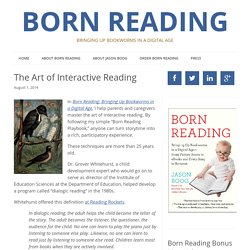
By following my simple “Born Reading Playbook,” anyone can turn storytime into a rich, participatory experience. These techniques are more than 25 years old. Dr. Grover Whitehurst, a child development expert who would go on to serve as director of the Institute of Education Sciences at the Department of Education, helped develop a program called “dialogic reading” in the 1980s. Www.joanganzcooneycenter.org/wp-content/uploads/2011/12/jgc_coviewing_desktop.pdf. Device Ownership Over Time.
Children’s Librarians as Digital Media Mentors. There are approximately 16,000 public library branches and bookmobiles in the United States, most of them with staff trained specifically to serve young children and their families.
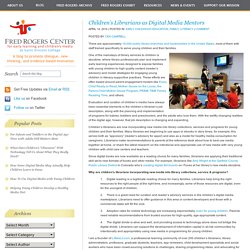
One of the mainstays of library services to children is storytime, where library professionals plan and implement early learning experiences designed to expose families with young children to high quality content (reader’s advisory) and model strategies for engaging young children in literacy-supportive practices.
These efforts are often based around parent engagement models like Every Child Ready to Read, Mother Goose on the Loose, the Parent-Child Mother Goose Program, PRIME TIME Family Reading Time, and others. The New Coviewing: Investigating and Designing for Joint Media Engagement. In the 1980s, communications researchers discovered that children whose parents talk about Sesame Street as they watch learn more from the show.
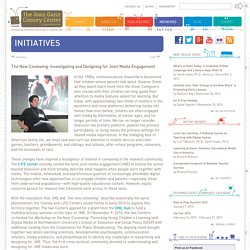
Caregivers who coview with their children can help guide their attention to media features salient for learning. But today, with approximately two-thirds of mothers in the workforce and more platforms delivering media into homes than ever before, children are often engaged with media by themselves, at earlier ages, and for longer periods of time. We can no longer consider television the primary platform, parents the primary participants, or living rooms the primary settings for shared media experiences.
In the changing face of American family life, we must now also turn our attention to mobile devices and video games; teachers, grandparents, and siblings; and schools, after-school programs, museums, and the backseats of cars. 12 KeyMessages Technology. 21st Century Skills Definitions. The IMLS Project Team and Task Force considered the list of skills commonly referred to as "21st Century Skills" and modified it slightly to better align with library and museum priorities.1 The resulting list includes the following additions: Basic Literacy, Scientific & Numerical Literacy, Visual Literacy, Cross-Disciplinary Skills, and Environmental Literacy.
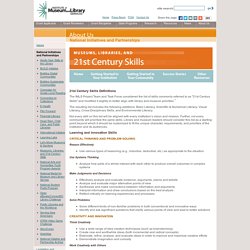
Not every skill on this list will be aligned with every institution’s vision and mission. Further, not every community will prioritize the same skills. Library and museum leaders should consider this list as a starting point beyond which it should be customized to fit the unique character, requirements, and priorities of the institution and its audiences. Reason Effectively Use various types of reasoning (e.g., inductive, deductive, etc.) as appropriate to the situation Use Systems Thinking Analyze how parts of a whole interact with each other to produce overall outcomes in complex systems Make Judgments and Decisions Solve Problems 1.
Zero to Eight: Children’s Media Use in America 2013. Cdn.nmc.org/media/2014-nmc-horizon-report-library-EN.pdf. Young Children, New Media & Libraries Survey: The Results Are In! Have you heard that librarians are using new media in their programming for young children?
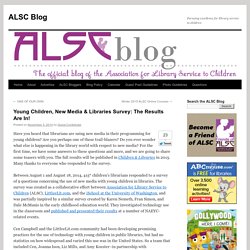
Are you perhaps one of these trail-blazers? Do you ever wonder what else is happening in the library world with respect to new media? For the first time, we have some answers to these questions and more, and we are going to share some teasers with you. The full results will be published in Children & Libraries in 2015. Many thanks to everyone who responded to the survey. More than E-book vs. Print: The Concept of ‘Media Mentors’ This summer, the School Library Journal stoked a debate long simmering in libraryland.
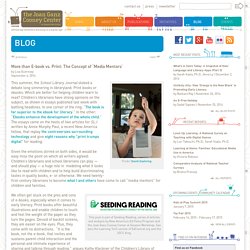
Print books or ebooks: Which are better for helping children learn to read? Children’s librarians have strong opinions on the subject, as shown in essays published last week with battling headlines. In one corner of the ring: “The book is far superior to the ebook for literacy.” In the other: “Ebooks enhance the development of the whole child.”
An Update On Screen Time : NPR Ed. NPR Ed is updating some of the top stories we've been following in 2014.
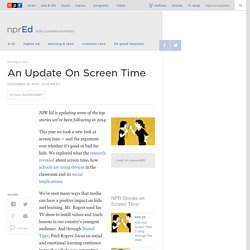
This year we took a new look at screen time — and the argument over whether it's good or bad for kids. We explored what the research revealed about screen time, how schools are using devices in the classroom and its social implications. We've seen many ways that media can have a positive impact on kids and learning. Mr. Rogers used his TV show to instill values and teach lessons in our country's youngest audience.
The long-standing recommendation from the American Academy of Pediatrics has been that kids' entertainment screen time be limited "to less than one or two hours per day. " But those restrictions may also be evolving. "We don't want to risk appearing so out of touch that we're irrelevant and people won't take our advice seriously," says Dimitri Christakis, a pediatrician on the AAP Council on Communication and Media.